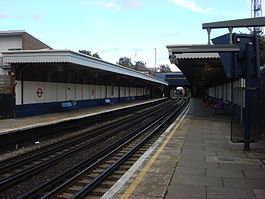Harlesden station
| Harlesden | |
|---|---|
 | |
 Harlesden Location of Harlesden in Greater London | |
| Location | Harlesden |
| Local authority | London Borough of Brent |
| Managed by | London Underground[1] |
| Owner | Network Rail |
| Station code | HDN |
| DfT category | E |
| Number of platforms | 2 |
| Fare zone | 3 |
| London Underground annual entry and exit | |
| 2016 | |
| 2017 | |
| 2018 | |
| 2019 | |
| 2020 | |
| National Rail annual entry and exit | |
| 2016–17 | |
| 2017–18 | |
| 2018–19 | |
| 2019–20 | |
| 2020–21 | |
| Key dates | |
| 15 June 1912 | Opened |
| Other information | |
| External links | |
| WGS84 | 51°32′11″N 0°15′28″W / 51.5364°N 0.2578°WCoordinates: 51°32′11″N 0°15′28″W / 51.5364°N 0.2578°W |
Harlesden is a Network Rail station on Acton Lane in northwest London, served by London Overground and by London Underground Bakerloo line trains. The railway line here is the border between the Harlesden and Stonebridge residential area in the east, and the Park Royal industrial estate to the west. The southern end of Willesden Brent Sidings separates the station from the West Coast Main Line.
History[]
The first station at the site was Willesden which was opened in 1841 by the London and Birmingham Railway and closed in 1866, replaced by Willesden Junction station, 0.5 miles (0.80 km) to the south east. In the Watford DC Line program of new electrified suburban tracks of the London and North Western Railway, a new station, "Harlesden", opened on 15 June 1912. Bakerloo line services on the same tracks began on 16 April 1917, via a new junction at Queens Park station. The Watford Junction to Euston modernisation project was completed in 1922.
Transport links[]
London bus routes 187, 206, 224, 226, 228, 260 and 487.
References[]
- ^ "Safety boost as London Underground to take control of 11 Silverlink stations". Transport for London. 5 December 2006. Archived from the original on 13 December 2014. Retrieved 19 February 2015.
- ^ a b "Multi-year station entry-and-exit figures (2007–2017)". London Underground station passenger usage data. Transport for London. January 2018. Archived from the original (XLSX) on 31 July 2018. Retrieved 22 July 2018.
- ^ "Station Usage Data" (CSV). Usage Statistics for London Stations, 2018. Transport for London. 21 August 2019. Archived from the original on 22 May 2020. Retrieved 27 April 2020.
- ^ "Station Usage Data" (XLSX). Usage Statistics for London Stations, 2019. Transport for London. 23 September 2020. Archived from the original on 9 November 2020. Retrieved 9 November 2020.
- ^ "Station Usage Data" (XLSX). Usage Statistics for London Stations, 2020. Transport for London. 16 April 2021. Retrieved 1 January 2022.
{{cite web}}: CS1 maint: url-status (link) - ^ a b c d e "Estimates of station usage". Rail statistics. Office of Rail Regulation. Please note: Some methodology may vary year on year.
External links[]
| Wikimedia Commons has media related to Harlesden railway station. |
- Train times and station information for Harlesden station from National Rail
- Rail transport stations in London fare zone 3
- DfT Category E stations
- Bakerloo line stations
- Tube stations in the London Borough of Brent
- Railway stations in the London Borough of Brent
- Former London and North Western Railway stations
- Railway stations in Great Britain opened in 1912
- Railway stations served by London Overground
- 1912 establishments in England
